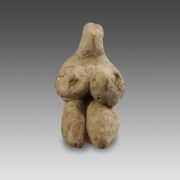Sabaean Stela with Head of a Dignitary
Sabaean Stela with Head of a Dignitary
The stele shaped as a rectangular plaque presents a male face in relief. Below the head there is an inscription of six letters in South Arabic language.
1st century A.D., 2nd century B.C.
H: 27.4 cm
Out of stock
Product Description
The stele shaped as a rectangular plaque presents a male face in relief. Below the head there is an inscription of six letters in South Arabic language (reading from right to left and transcribing with Latin letters hwf’tt). With all the probability, this is the name Hawfi[‘ath], who was the owner of the stele. The name signifies Athtar saved and is attested among the other persons who died in this region in the same period (Athtar is the name of one of the most important divinities of the South Arabian pantheon, it is the male counterpart to the Mesopotamian Ishtar who presided the war and fertility).
The head is oblongue with highly stylized facial features. The beard at the chin and a relief line above the forehead frame the face. The treatment of the skin, smooth and tense, does not show a furrow nor an expression. This became very common for South Arabian figures, though different from one another, they never are the real individual portraits. The face and surface below, including the inscription, are decorated with red paint, a state of conservation that is remarkable as typically there are only few traces of this kind of decoration preserved on similar objects.
The great variety of human representations in South Arabian art is surprising: there are standing and seated figures as well as reliefs and objects shaped as heads with long necks. The fact that they come mostly from the necropolises clearly indicate that these are the images of the deceased installed at their graves : the presence of the inscription attests the name of the person, the relation to the clan and his status.







